Uscg
-
- OSHA Standards Applicable on Uninspected Vessels Maritime Reporter, May 2002 #10
There has been much ado over the recent Supreme Court ruling that a commercial uninspected drilling vessel must comply with applicable Occupational Safety and Health Administration (OSHA) standards since the vessel was not regulated by under the USCG inspected vessel standards. Those in the know within the industry do not regard this ruling as anything of great consequence, but rather a return to nationally uniform rulings of the law.
The case Choa V. Mallard Bay Drilling, Inc. involved an explosion onboard the inland drilling barge RIG 52 in June of 1997. The RIG 52 was in Louisiana waters and was nearing completion of a well when an explosion occurred killing four crewmen and injuring two others. The USCG investigation found that the inland drilling vessel had never been inspected by the USCG nor was there any requirement that it be inspected or hold a Coast Guard issued Certificate of Inspection.
Their report noted that the USCG "does not regulate mineral drilling operations in state waters, and does not have the expertise to adequately analyze all issues relating to the failure of an oil/natural gas well." The USCG investigation focused on vessel related issues.
The USCG determined that natural gas leaked from the well, spread throughout the barge, and was most likely ignited by sparking originating in electrical equipment in the pump room.
Based principally upon the USCG investigation, OSHA issued three citations concerning the operating company's failure to evacuate their personnel, failure to have an emergency response plan and failure to train employees in emergency response. An Administrative Law Judge (ALJ) found that the uninspected inland drilling vessel was a "workplace" under the OSHA standards and that the citations were appropriate.
When the case got to the 5th Circuit Court of Appeals in New Orleans, they reversed the ruling, indicating that the uninspected vessel standards of the USCG that were applicable to RIG 52 were sufficient to establish exclusive USCG jurisdiction even though many of those same standards did not apply to RIG 52 because it was not self-propelled.
The 5th Circuit ruling went counter to all other jurisdictions in the US and was generally considered to be an aberration.
The Supreme Court entered the fray to resolve the difference between the 5th Circuit and the rest of the country.
The Supreme Court ruled that the USCG regulations for uninspected vessels were in this case not adequate to preempt application of the OSHA standards. There is broad general agreement that the USCG inspected vessel standards preempt the application of OSHA standards to those vessels holding USCG Certificates of Inspection. It is the normally accepted premise that the USCG uninspected vessel standards do not preempt the application of OSHA standards to uninspected vessels.
The Supreme Court indicated that uninspected vessel regulations do not address occupational safety and health concerns faced during inland drilling vessel operations.
While this ruling is narrow and only applies directly to uninspected (by the USCG) inland drilling vessels, it nonetheless provides a fairly clear direction and restores the US to one overall national view concerning the relationship between OSHA and the USCG.
It now seems inevitable that OSHA standards will be applied to most if not all uninspected vessels. This list will probably include inland industrial vessels, inland and seagoing towboats. inland and seagoing cargo barges and inland drilling vessels.
There has been talk about various maritime segments seeking legislation from the Congress, bringing their specific vessels under USCG inspection to protect themselves from OSHA. The rationale behind this move would be based upon the belief that it is better to work with the USCG than it would be to work with OSHA. It is not at all clear that many companies endorse this policy.
At this time it does not look like there will be any mass petitioning of the Congress to broaden the various classes of vessels currently inspected by the USCG.
OSHA has been around for more than 25 years. The Congress has limited their budget as a means of preventing them from overly aggressive industry inspections.
Despite this OSHA has had and will continue to have major impact upon all elements of the maritime, even upon USCG inspected vessels, although indirecti ly.
Confined space entry, HAZWOPER training, in depth personal protective equipment standards, and competent person inspections are a few of the OSHA generated issues that now tend to impact everyone in the maritime. It is anticipated that future USCG rule makings will include more extensive occupational safety components.
The USCG has already started this process by the inclusion of these issues in the December 1999 proposed changes to the Outer Continental Shelf Activities rules at 33 CFR Subchapter N. While it is not at all clear that these proposals will all become final rules, the proposal demonstrates present USCG thinking on the subject. Many would say that these proposed OSHA type rulings should be applicable to all commercial inspected vessels and not just those vessels engaged in the offshore oil industry.
The specific USCG OCS proposed workplace safety and health standards included: Personal Protective Equipment • Eye and face • Head • Feet • Hearing • Clothing • Respiratory • Fall arrest • Radiation • Airborne Substances • Infectious material General Workplace Conditions • Electrical work • Lockout/Tagout • Noise C h a r l e y Havnen • Machine guards • Equipment use and maintenance • Slings • Personnel transfer nets Confined space entry • General • Entry requirements • Prior to entry • Preparing space for entry • Calibrating atmospheric test equipment • Atmospheric testing • Permits, Certificates & logs • Restrictions on equipment and work • Testing and protective Equipment • Personnel training • Rescue team • Offshore competent person Does it really matter if these standards come at the industry from OSHA or the USCG? In the past it was often said that the USCG understood the maritime far better than OSHA. It is also true that the USCG's empathy with the maritime in recent times has not been particularly favorable as evidenced by the USCG methodology involved in the implementation of the Standards of Training, Certificating, and Watchkeeping (STCW).
It would seem that eventually OSHA standards will apply directly to uninspected commercial vessels and OSHA type standards will be issued by the USCG for all inspected vessels. Unfortunately, implementing these issues will probably the USCG's current focus on security issues and other long term Administration funding problems.
Final resolution of all occupational safety and health issues in the maritime will likely take 10 years or more to resolve.
Charley Havnen is a Commander USCG Ret. His organization can help you with your vessel construction project, regulatory problems, vessel manning issues, procedure manuals, accident analysis or expert witness. His organization can do what you can't or don't want to do. He can be reached by contacting the Havnen Group: (800) 493-3883 or (504) 394-8933, fax: (504) 394-8869.
-
- Anatomy of a Marine Casualty Investigation Maritime Reporter, Jan 2020 #24
it is important to note that although not required, it is not unusual for the National Transportation Safety Board (NTSB) and the United States Coast Guard (USCG) to coordinate, in part, their efforts to investigate and establish the root cause of a marine casualty. The process by which the NTSB and USCG investigate
-
- Anatomy of a Marine Casualty Investigation Maritime Reporter, Jan 2020 #24
it is important to note that although not required, it is not unusual for the National Transportation Safety Board (NTSB) and the United States Coast Guard (USCG) to coordinate, in part, their efforts to investigate and establish the root cause of a marine casualty. The process by which the NTSB and USCG investigate
-
- Many Different Vessels but One Goal – Passenger Safety Marine News, Feb 2024 #22
Island, Calif. It’s hard to imagine any captain or maritime operator not paying close attention to all of the issues raised by the U.S. Coast Guard (USCG) or the National Transportation Safety Board (NTSB), even though most vessels may have little in common with a DUKW or dive boat.This broader focus
-
- New Ballast Water Management Regulations Maritime Logistics Professional, Q4 2013 #54
Ready or not, here it comes. Are you prepared? In March 2012, the U.S. Coast Guard (USCG) amended its regulations on ballast water management by establishing standards for the allowable concentration of marine organisms in ballast waters discharged in ports and coastal areas of the United States. The new
-
- Last-minute Tips for Subchapter M Marine News, May 2018 #22
Countdown to Subchapter M: Last-minute tips for choosing the USCG or TPO/TSMS option ...Subchapter M will finally be implemented in the tugboat and towing industry in only a few short months. It has taken over ten years to arrive, but the build-up and in some cases, hysteria, can only be compared to the Y2K
-
- The USCG RDC & Electronic Aids To Navigation Maritime Reporter, Oct 2018 #14
the familiar “Red, Right, Returning” mantra. Fast forwarding to the 21st century, in response to the terrorist attack in 2001, Congress authorized the USCG to develop a Nationwide Automated Identification System (NAIS) which is now operational in 69 major U.S. ports and waterways. NAIS enabled a sophisticated
-
- Op/Ed: Act Now to Avoid BWMS Compliance Risks Marine News, Oct 2017 #22
Lately, I have been reading reports regarding the United States Coast Guard’s (USCG) escalating enforcement of ballast water discharge violations. In the first case, the USCG initiated a civil penalty proceeding against a bulk carrier for discharging ballast water in Washington State without using a USCG
-
- Enterprise Revisited: Titanium is the USCG Vessel Procurement Magic Bullet Maritime Reporter, Jun 2021 #14
In my May 2020 MREN USS Enterprise column I made a reference to the benefits of titanium as a hull structural material.It related to the life of the USCG cutter Bear and I concluded the column with a suggestion that titanium would be a particularly useful and cost-effective structural material for sail
-
- The USCG, MTSA '02 and IMO - The New Faces of Security Maritime Reporter, Feb 2003 #8
, foreign vessels that call on US ports and US facilities that engage in international trade. In many respects they mirror MSTA '02. The USCG has made it very clear that these international security requirements will be applied to domestic trade vessels that meet the criteria and to domestic
-
- Rear Admiral Pluta Redefines Maritime Security Maritime Reporter, Jun 2002 #64
America's need for port protection. "America needed this (the added funds)," Pluta said. "We didn't know when the next attack would be coming. We (USCG) had to protect our ports ... that's our job." While things seem to be "back to normal," the USCG will surely not push port security to the side
-
- Just in Time: ABS Ballast Water Treatment Advisory Maritime Logistics Professional, Q4 2014 #42
expanded advisory also covers some of the requirements for ballast water management (BWM) in the United States, such as the U.S. Coast Guard’s (USCG) ballast water management regulations, the Environmental Protection Agency’s Vessel General Permit and ballast water regulations for various states
-
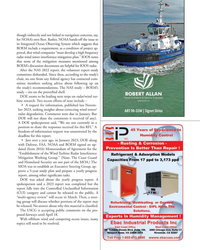 )
April 2024 - Marine News page: 25
)
April 2024 - Marine News page: 25occur in March. Then, a steer- ing group will discuss whether portions of the report may be released. No answer about why this material is classi? ed. The USCG is accepting public comments on the pro- posed fairways until April 18. With offshore wind and competing ocean issues, many topics still need to be
-
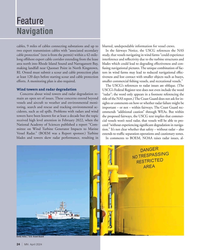 )
April 2024 - Marine News page: 24
)
April 2024 - Marine News page: 24and up to blurred, undependable information for vessel crews. two export transmission cables with “associated secondary In the fairways Notice, the USCG references the NAS cable protection” (text is from the permit) within a 42-mile- study, that vessels navigating in wind farms “could experience long
-
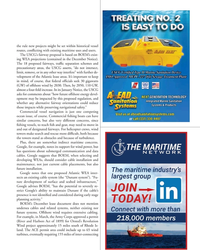 )
April 2024 - Marine News page: 23
)
April 2024 - Marine News page: 23the rule new projects might be set within historical vessel routes, con? icting with existing maritime uses and users. The USCG’s fairway proposal is based on BOEM’s exist- ing WEA projections (contained in the December Notice). The 18 proposed fairways, traf? c separation schemes and precautionary
-
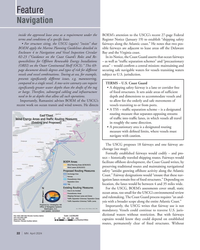 )
April 2024 - Marine News page: 22
)
April 2024 - Marine News page: 22Feature Navigation inside the approved lease area as a requirement under the BOEM’s attention to the USCG’s recent 27-page Federal terms and conditions of a speci? c lease. Register Notice (January 19) to establish “shipping safety • For structure siting, the USCG (again) “insists” that fairways along
-
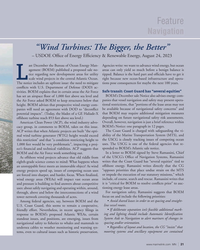 )
April 2024 - Marine News page: 21
)
April 2024 - Marine News page: 21(WTG) height would exceed ability of the Marine Transportation System (MTS), and this restriction” and that “a condition restricting height to the USCG is closely tracking issues of competing ocean uses. The USCG is one of the federal agencies that re- 1,000 feet would be very problematic”, impacting
-
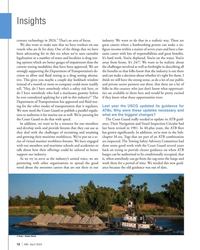 )
April 2024 - Marine News page: 12
)
April 2024 - Marine News page: 12opportunities were. Department of Transportation has approved oral ? uid test- ing for the other modes of transportation that it regulates. Last year the USCG updated its guidance for We now need the Coast Guard to publish a parallel regula- ATBs. Why were these updates necessary and tion to authorize it
-
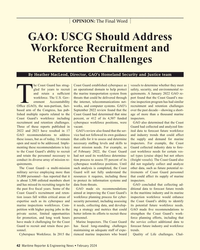 )
February 2024 - Maritime Reporter and Engineering News page: 42
)
February 2024 - Maritime Reporter and Engineering News page: 42OPINION: The Final Word GAO: USCG Should Address Workforce Recruitment and Retention Challenges By Heather MacLeod, Director, GAO’s Homeland Security and Justice team he Coast Guard has strug- Coast Guard established cyberspace as vessels to determine whether they meet gled for years to recruit an
-
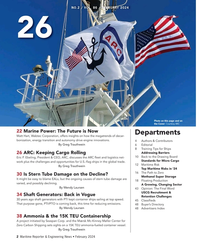 )
February 2024 - Maritime Reporter and Engineering News page: 2
)
February 2024 - Maritime Reporter and Engineering News page: 2stern tube damage are 18 Floating Production varied, and possibly declining. A Growing, Changing Sector By Wendy Laursen 43 Opinion: The Final Word USCG Recruitment & 34 Shaft Generators: Back in Vogue Retention Challenges 30 years ago shaft generators with PTI kept container ships sailing at top speed
-
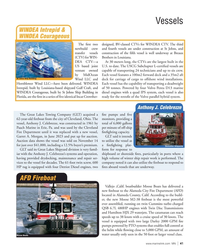 )
February 2024 - Marine News page: 41
)
February 2024 - Marine News page: 41at Breaux (CTV) for WIN- Brothers in Louisiana. DEA CTV—a At 30 meters long, the CTVs are the largest built in the US based joint U.S. to date. The USCG Subchapter L-certi? ed vessels are venture owned capable of transporting 24 technicians and up to six crew. by MidOcean Each vessel features a 100m2
-
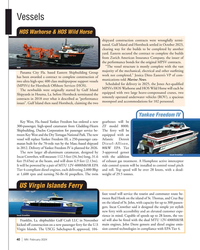 )
February 2024 - Marine News page: 40
)
February 2024 - Marine News page: 40ferry for the U.S main engines, John Deere gensets and diesel engine emis- sion control technologies in compliance with EPA Tier 4. Virgin Islands. The USCG Subchapter-K approved, 104- 40 | MN February 202
-
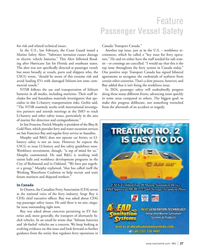 )
February 2024 - Marine News page: 27
)
February 2024 - Marine News page: 27the ferry system in Canada today.” but more broadly at vessels, ports and shippers who, the One positive step: Transport Canada has signed bilateral USCG wrote, “should be aware of this extreme risk and agreements to recognize the credentials of seafarers from avoid loading EVs with damaged lithium-ion
-
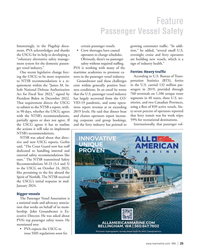 )
February 2024 - Marine News page: 25
)
February 2024 - Marine News page: 25vessels. growing commuter traf? c. “In addi- ment, PVA acknowledges and thanks • Crew shortages have caused tion,” he added, “several small U.S. the USCG for its help in developing a operators to change schedules. overnight cruise and ferry operators “voluntary alternative safety manage- Obviously
-
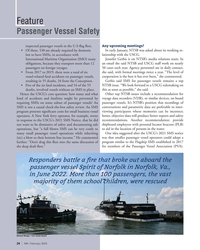 )
February 2024 - Marine News page: 24
)
February 2024 - Marine News page: 24, 530 are already required by domestic In early January, NTSB was asked about its working re- law to have SMSs, in accordance with lationship with the USCG. International Maritime Organization (IMO) treaty Jennifer Gerbis is on NTSB’s media relations team. In obligations, because they transport more
-
 )
February 2024 - Marine News page: 23
)
February 2024 - Marine News page: 23Cruz Island, Calif. It’s hard to imagine any captain or maritime operator not paying close attention to all of the is- sues raised by the U.S. Coast Guard (USCG) or the National Transportation Safety Board (NTSB), even though most ves- sels may have little in common with a DUKW or dive boat. This broader focus
-
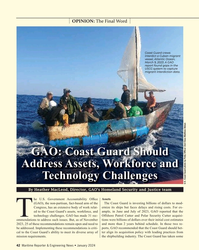 )
January 2024 - Maritime Reporter and Engineering News page: 42
)
January 2024 - Maritime Reporter and Engineering News page: 42OPINION: The Final Word Coast Guard crews interdict a Cuban migrant vessel, Atlantic Ocean, March 9, 2023. A GAO report found gaps in the USCG system to capture migrant interdiction data. GAO: Coast Guard Should Address Assets, Workforce and Technology Challenges U.S. Coast Guard photo by Petty
-
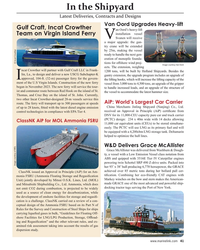 )
January 2024 - Maritime Reporter and Engineering News page: 41
)
January 2024 - Maritime Reporter and Engineering News page: 41ncat Crowther will partner with Gulf Craft LLC in Frank- 1200 tons, will be built by Holland Shipyards. Besides the lin, La., to design and deliver a new USCG Subchapter-K gantry extension, the upgrade program includes an upgrade of Iapproved, 104-ft. (32-m) passenger ferry for the govern- the lifting hooks
-
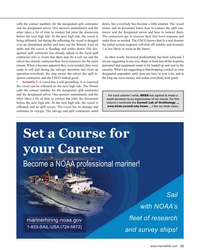 )
January 2024 - Maritime Reporter and Engineering News page: 11
)
January 2024 - Maritime Reporter and Engineering News page: 11contractors get to exercise their ? rst level response and being re? oated, but during the re? oating the vessel is dragged make ? xes as needed. The USCG knows that in a real disaster over an abandoned anchor and tears out the bottom. Fuel oil the initial system response will kick off reliably and Scenario
-
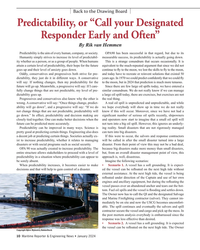 )
January 2024 - Maritime Reporter and Engineering News page: 10
)
January 2024 - Maritime Reporter and Engineering News page: 10The Owner now has to call the QI and the designated Salvage and Marine Fire? ghting contractor (salvor). They cannot im- mediately be on site and now the USCG becomes uncomfort- able. The spill continues and eventually the salvors and spill contractor secure the vessel and cargo and pick up the mess. In the
-
![MR Dec-23#41 to]
States Coast Guard (USCG). NAVTOR digital logbooks](https://images.marinelink.com/images/magazines/w200h250c/MaritimeReporter-202312-page43.png) )
December 2023 - Maritime Reporter and Engineering News page: 41
)
December 2023 - Maritime Reporter and Engineering News page: 41? rst solutions in the market to receive formal approval from the United and emerging] regulation, as regulation will [continue to] States Coast Guard (USCG). NAVTOR digital logbooks are designed drive a lot of these things. There's a lot of confusion about to streamline log-keeping routines and assist
-
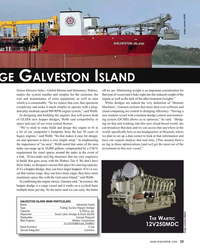 )
December 2023 - Maritime Reporter and Engineering News page: 33
)
December 2023 - Maritime Reporter and Engineering News page: 33, Webb noted that some of the urea no lag in those optimizations [and we] get the most out of the tanks can range up to 10,000 gallons, compounded by a USCG investment in this new vessel.” requirement for crawl spaces around the tanks in the event of a leak. “[Urea tanks are] big structures that are very
-
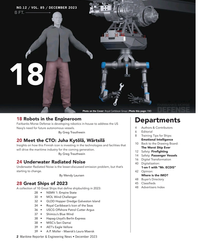 )
December 2023 - Maritime Reporter and Engineering News page: 2
)
December 2023 - Maritime Reporter and Engineering News page: 2in 2023: 28 • NSMV 1: Empire State 30 • MOL Wind Challenger 32 • GLDD Hopper Dredge Galveston Island 34 • Royal Caribbean’s Icon of the Seas 36 • USCG Offshore Patrol Cutter Argus 37 • Shimizu’s Blue Wind 38 • Hapag-Lloyd’s Berlin Express 38 • MISC’s Seri Damai 39 • AET’s Eagle Vellore 39 • A
-
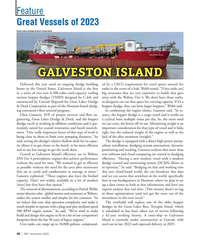 )
November 2023 - Marine News page: 48
)
November 2023 - Marine News page: 48Feature Great Vessels of 2023 Great Lakes Dredge & Dock Corporation GALVESTON ISLAND Delivered this year amid an ongoing dredge building ed by a USCG requirement for crawl spaces around the boom in the United States, Galveston Island is the ? rst tanks in the event of a leak, Webb noted. “[Urea
-
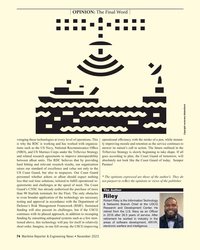 )
November 2023 - Maritime Reporter and Engineering News page: 74
)
November 2023 - Maritime Reporter and Engineering News page: 74are necessary Robert Riley is the Information Technology testing and approval in accordance with the Department of & Networks Branch Chief at the USCG Defense’s Risk Management Framework (RMF). Sustained Research and Development Center. He funding will also present its challenges, but if the USCG
-
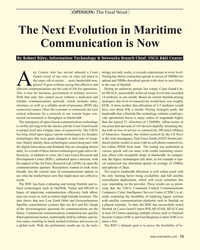 )
November 2023 - Maritime Reporter and Engineering News page: 73
)
November 2023 - Maritime Reporter and Engineering News page: 73OPINION: The Final Word The Next Evolution in Maritime Communication is Now By Robert Riley, Information Technology & Networks Branch Chief, USCG R&D Center ny Coastie who has served onboard a Coast nology not only works, it exceeds expectations at every level. Guard vessel of any size, or class can
